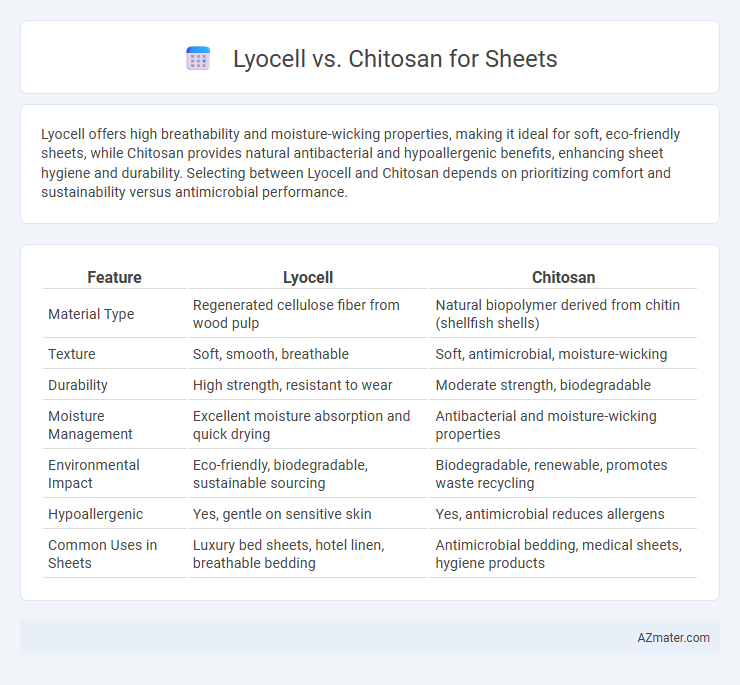Lyocell offers high breathability and moisture-wicking properties, making it ideal for soft, eco-friendly sheets, while Chitosan provides natural antibacterial and hypoallergenic benefits, enhancing sheet hygiene and durability. Selecting between Lyocell and Chitosan depends on prioritizing comfort and sustainability versus antimicrobial performance.
Table of Comparison
| Feature | Lyocell | Chitosan |
|---|---|---|
| Material Type | Regenerated cellulose fiber from wood pulp | Natural biopolymer derived from chitin (shellfish shells) |
| Texture | Soft, smooth, breathable | Soft, antimicrobial, moisture-wicking |
| Durability | High strength, resistant to wear | Moderate strength, biodegradable |
| Moisture Management | Excellent moisture absorption and quick drying | Antibacterial and moisture-wicking properties |
| Environmental Impact | Eco-friendly, biodegradable, sustainable sourcing | Biodegradable, renewable, promotes waste recycling |
| Hypoallergenic | Yes, gentle on sensitive skin | Yes, antimicrobial reduces allergens |
| Common Uses in Sheets | Luxury bed sheets, hotel linen, breathable bedding | Antimicrobial bedding, medical sheets, hygiene products |
Introduction to Lyocell and Chitosan Sheets
Lyocell sheets are crafted from sustainably sourced wood pulp using a closed-loop solvent spinning process that produces soft, breathable, and moisture-wicking fabric ideal for sensitive skin. Chitosan sheets leverage the natural biopolymer derived from crustacean shells, known for its antibacterial properties and biodegradability, making them effective in medical and hygiene applications. Both materials offer eco-friendly alternatives to conventional textiles, with Lyocell excelling in comfort and Chitosan providing enhanced antimicrobial protection.
Material Composition and Source
Lyocell sheets are made from cellulose fibers derived primarily from sustainably harvested eucalyptus trees, known for their eco-friendly production process involving non-toxic solvents. Chitosan sheets incorporate a biopolymer extracted from the exoskeletons of crustaceans such as shrimp and crabs, offering natural antibacterial and moisture-wicking properties. The material composition of Lyocell emphasizes plant-based cellulose with high breathability, while Chitosan combines polysaccharides with inherent antimicrobial benefits specific to marine-based sources.
Manufacturing Processes Compared
Lyocell production employs a closed-loop process where cellulose from wood pulp is dissolved in N-methylmorpholine N-oxide and regenerated into fibers, minimizing environmental impact through solvent recovery. Chitosan fabrication involves deacetylating chitin derived from crustacean shells, followed by chemical or enzymatic modification to form films or fibers suitable for sheets. Lyocell's manufacturing emphasizes sustainable wood sourcing and solvent recycling, while chitosan processing focuses on biopolymer extraction and effective purification to retain antimicrobial properties.
Environmental Impact: Lyocell vs Chitosan
Lyocell is a sustainable fiber produced from wood pulp using a closed-loop process that recycles water and solvents, minimizing environmental pollution and reducing carbon footprint. Chitosan, derived from crustacean shells, is biodegradable and has antimicrobial properties but its environmental impact depends on the sourcing and processing of raw materials, which may involve chemical treatments. Comparing both, Lyocell offers a more consistent eco-friendly production with lower water and energy consumption, while Chitosan provides added functional benefits but requires careful management of waste and chemical use during manufacturing.
Comfort and Feel on Skin
Lyocell fibers offer exceptional softness, breathability, and moisture-wicking properties, providing a smooth, cool feel ideal for sensitive skin. Chitosan-infused sheets enhance anti-bacterial protection and skin health benefits while maintaining a gentle texture that resists odors and irritation. Combining Lyocell's silk-like comfort with Chitosan's natural antimicrobial qualities ensures sheets that promote both luxurious softness and lasting freshness.
Durability and Longevity
Lyocell fibers exhibit high tensile strength and excellent resistance to wear, significantly enhancing sheet durability and extending lifespan under regular use. Chitosan-treated fabrics provide antimicrobial properties but generally have lower mechanical robustness compared to Lyocell, potentially reducing longevity in sheets. Choosing Lyocell for sheets ensures superior durability and sustained quality, making it more suitable for long-term usage where fabric strength is critical.
Moisture Absorption and Breathability
Lyocell fibers exhibit superior moisture absorption rates, often absorbing up to 50% of their weight in water, which enhances breathability and sweat-wicking properties in sheets. Chitosan, derived from chitin, offers antimicrobial benefits but has comparatively lower moisture absorption and breathability than Lyocell, making it less effective in managing humidity during sleep. Combining Lyocell's moisture management with Chitosan's antimicrobial properties can create sheets that maximize comfort and hygiene.
Hypoallergenic and Antibacterial Properties
Lyocell fibers exhibit natural hypoallergenic properties due to their smooth surface and moisture-wicking ability, which reduces skin irritation and allergen buildup in sheets. Chitosan, derived from crustacean shells, offers strong antibacterial properties by inhibiting bacterial growth and preventing odors, making it ideal for maintaining hygienic bedding environments. Combining Lyocell's breathability with Chitosan's antimicrobial effects results in sheets that provide enhanced comfort and protection for sensitive skin.
Cost and Market Availability
Lyocell offers a competitive cost advantage due to large-scale production and established supply chains, making it widely available in the global textile market. Chitosan sheets, derived from crustacean shell waste, tend to be more expensive due to complex extraction processes and limited industrial-scale manufacturing. Market availability for Lyocell is significantly higher, supported by numerous suppliers and diverse applications, whereas chitosan sheet products remain niche with constrained accessibility.
Conclusion: Choosing the Right Sheet Material
Lyocell offers excellent moisture-wicking and breathability, making it ideal for hot sleepers seeking comfort and sustainability. Chitosan sheets provide natural antibacterial and hypoallergenic properties, benefiting those with sensitive skin or allergies. Selecting the right sheet material depends on prioritizing either advanced moisture management with Lyocell or enhanced antimicrobial protection with Chitosan.

Infographic: Lyocell vs Chitosan for Sheet
 azmater.com
azmater.com